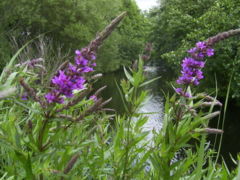Lythrum
| Lythrum subsp. var. | ||||||||||||||||||||||||||||||||||||||||||||||||||||||||
|---|---|---|---|---|---|---|---|---|---|---|---|---|---|---|---|---|---|---|---|---|---|---|---|---|---|---|---|---|---|---|---|---|---|---|---|---|---|---|---|---|---|---|---|---|---|---|---|---|---|---|---|---|---|---|---|---|

|
|
| ||||||||||||||||||||||||||||||||||||||||||||||||||||||
| ||||||||||||||||||||||||||||||||||||||||||||||||||||||||
Lythrum is a genus commonly known as loosestrife. It is one of 32 genera of the family Lythraceae.
| Standard Cyclopedia of Horticulture |
|---|
|
Lythrum (Greek, blood; possibly from the styptic properties of some species, or the color of the flowers). Lythraceae. Herbs or subshrubs, of which three are cultivated in hardy borders. Branches 4-angled: lvs. opposite, or alternate, rarely whorled, linear-oblong or lanceolate, entire: fls. rosy purple or white, in the upper axils usually solitary, lower down more or less whorled; calyx-tube cylindrical, 8-12-ribbed; petals 4-6, obovate; stamens as many or twice as many: caps. 2-celled, with an indefinite number of seeds.—Koehne in his monograph of the Lythraceae recognizes 24 species, widely scattered. Lythrums grow about 2 to 3 feet high in the wild, but improve markedly in cultivation, often attaining 4 to 5 feet and flowering freely. Some of them are called willow-herbs from their strong, erect habit and willow-like leaves. They are of easy culture in any moist soil, and are usually planted amid shrubbery, where they hold their own. They are denizens of low grounds, swamps and meadows, often growing in the water. They flower in summer and are propagated by division.
|
Cultivation
Propagation
Pests and diseases
Species
- Lythrum alatum - Winged lythrum
- Lythrum californicum - California loosestrife
- Lythrum curtissii - Curtiss' loosestrife
- Lythrum flagellare - Florida loosestrife
- Lythrum hyssopifolia - Hyssop loosestrife
- Lythrum junceum
- Lythrum lineare - Wand lythrum
- Lythrum maritimum Kunth - Pūkāmole (Peru, [[Hawaii|HawaiTemplate:Okinai]])
- Lythrum ovalifolium - Low loosestrife
- Lythrum paradoxum
- Lythrum portula - Spatulaleaf loosestrife
- Lythrum salicaria - Purple loosestrife
- Lythrum thymifolia - Thymeleaf loosestrife
- Lythrum tribracteatum - Threebract loosestrife
- Lythrum virgatum - European wand loosestrife
Gallery
-
photo 1
-
photo 2
-
photo 3
References
- Standard Cyclopedia of Horticulture, by L. H. Bailey, MacMillan Co., 1963
External links
- w:Lythrum. Some of the material on this page may be from Wikipedia, under the Creative Commons license.
- Lythrum QR Code (Size 50, 100, 200, 500)
